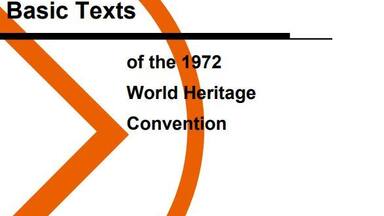49th anniversary of the World Heritage Convention, 16 November
The 16th of November marks the anniversary of the World Heritage Convention. The Convention has preserved UNESCO World Heritage, natural and cultural for 49 years.
This common heritage belonging to us all is the best of our world, and the best of who we are. However the recent United Nations Climate Change Conference (COP26) made it clear that if we do not adequately protect World Heritage sites against current challenges such as climate change, this will negatively impact future generations who inherit them. The story behind the emergence of the Convention reminds us of what we have achieved together and can inspire us to overcome the challenges facing World Heritage today.
Where it all began
The idea of creating an international movement for protecting heritage emerged after World War I. The 1972 Convention concerning the Protection of the World Cultural and Natural Heritage developed from the merging of two separate movements: the first focusing on the preservation of cultural sites, and the other dealing with the conservation of nature.
The event that aroused particular international concern was the decision to build the Aswan High Dam in Egypt, which would have flooded the valley containing the Abu Simbel temples, a treasure of ancient Egyptian civilization. In 1959, after an appeal from the governments of Egypt and Sudan, UNESCO launched an international safeguarding campaign. Archaeological research in the areas to be flooded was accelerated. Above all, the Abu Simbel and Philae temples were dismantled, moved to dry ground and reassembled.
The campaign cost about US$80 million, half of which was donated by some 50 countries, showing the importance of solidarity and nations' shared responsibility in conserving outstanding cultural sites. Its success led to other safeguarding campaigns, such as for saving the Archaeological Ruins at Moenjodaro (Pakistan), and restoring the Borobodur Temple Compounds (Indonesia).
Consequently, UNESCO initiated, with the help of the International Council on Monuments and Sites (ICOMOS), the preparation of a draft convention on the protection of cultural heritage. This was complemented by a draft for natural heritage by the International Union for the Conservation of Nature (IUCN).
World Heritage Convention
The most significant feature of the 1972 World Heritage Convention is that it links together in a single document the concepts of nature conservation and the preservation of cultural properties. The Convention recognizes the way in which people interact with nature, and the fundamental need to preserve the balance between the two. The Convention defines the kind of natural or cultural sites which can be considered for inscription on the World Heritage List.
The Convention sets out the duties of States Parties in identifying potential sites and their role in protecting and preserving them. By signing the Convention, each country pledges to conserve not only the World Heritage sites situated on its territory, but also to protect its national heritage. The States Parties are encouraged to integrate the protection of the cultural and natural heritage into regional planning programmes, set up staff and services at their sites, undertake scientific and technical conservation research and adopt measures which give this heritage a function in the day-to-day life of the community.
Success
World Heritage sites have benefitted and improved their state of conservation through protection by the Convention. For example, Angkor (Cambodia), has completed more than 60 projects thanks to contributions from more than 20 countries.
Another example is Comoé National Park (Côte d’Ivoire), one of the largest protected areas in West Africa, inscribed on the List of World Heritage in Danger in 2003, following the outbreak of civil conflict in the country. After concerted and coordinated actions of the State Party and its strategic, technical and financial partners, it was finally removed from this List at the 41st session of the Committee in Krakow, Poland in 2017.
Belize Barrier Reef Reserve System, was on the List of World Heritage in Danger for ten years before it was finally removed at the 42nd session of the World Heritage Committee in Manama, Bahrain in July 2018. This was made possible by a strong and collaborative effort involving government, civil society and the scientific community, as well as the UNESCO World Heritage Centre, Advisory Bodies and the Committee with its decision-making power.
Learn more about World Heritage success stories in the World Heritage Review
Challenges
Still, the Convention faces many changes. Increasing threats to UNESCO World Heritage sites through extreme weather events, conflict and climate change affect people and their heritage. The COVID-19 pandemic also impacted sites through many closures.
UNESCO World Heritage sites are irreplaceable assets of humanity, but in order for us to ensure their protection, we must continue to fully implement the Convention for future generations to come. Stay tuned for the 50th anniversary celebration ...
Hear from site managers about the impact of COVID-19 on World Heritage management
Follow our regular map of World Heritage site closures
Read the latest issue of the World Heritage Review on Climate Change


